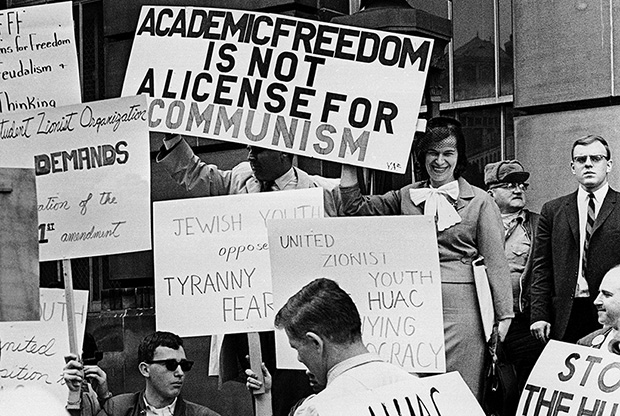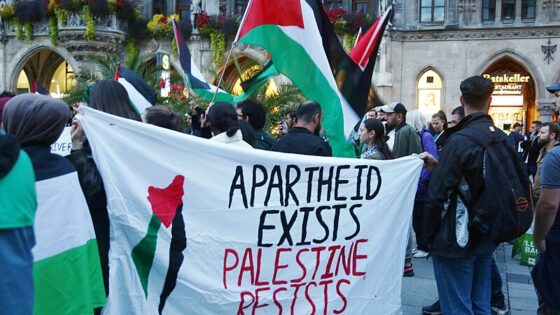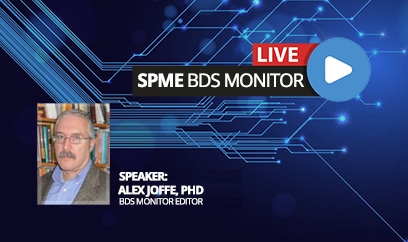
Pickets supporting and opposing a House subcommittee on un-American activities hearing into possible communist subversion in the Buffalo area in front of the U.S. Court House in Buffalo, New York, on April 30, 1964. (Lennox McLendon/AP)
Israeli Apartheid Week is upon us again, bringing with it the familiar parade of panels by pro-Palestinian student groups and counter-panels by pro-Israel student groups. This year, it comes in the midst of an ongoing controversy over support of the boycott, divestment, and sanctions movement—BDS—not by students, but by organizations of university professors.
Last December, the American Studies Association passed a resolution in support of BDS, urging its members to reject academic collaboration with universities and institutions affiliated directly or indirectly with the Israeli government. In response, more than 200 university and college presidents issued formal statements, and Brandeis, Penn State, Kenyon College, and Indiana University quickly withdrew their institutional membership of the ASA.
The ferocious debate before and after the ASA resolution vote raised questions about whether actions like it impinge on the academic freedom of Israeli scholars whose universities are subjected to boycott, though the text of the resolution explicitly exempts collaboration with individual Israeli professors without qualification of a litmus test of a professor’s politics. But overwhelmingly, the arguments pro and con have been about the exercise of academic freedom in American universities and within the larger American constitutional system.
The university presidents who condemned the ASA resolution overwhelmingly framed their opposition in terms of academic freedom. But how and why the principle of academic freedom applied in this case were in many instances not specifically addressed. Indeed, because the ASA is a voluntary organization, there is actually no connection between its actions—“extramural,” in legal parlance—and academic freedom. But as a result of the ensuing public discourse, “academic freedom” was reduced to a talking point and its meaning lost in the hullabaloo. That’s a shame, because in an important sense, the century-old struggle over academic freedom has been central to the story of the rise of Jewish academics, senior administrators and Jewish university presidents throughout the American academy.
***
The idea of academic freedom addresses the complex relationship between university governance and a professor’s right to speak and act as a private citizen outside his or her academic responsibilities. It is a recognized and generally honored exception to the American principle of employment at will, at least as a matter of academic conduct, although not always consistently as a legal principle.
In fact, “academic freedom” is hardly a historically immutable concept or value. The core document drafted almost a century ago by Committee A of the fledgling American Association of University Professors, the 1915 Declaration of Principles on Academic Freedom and Academic Tenure, has been repeatedly clarified, amended, and restated, each time attempting to define academic freedom within the context of whatever specific controversy was at issue and addressing the limits of interference by university authorities with faculty activities. An expanded declaration in the 1940 Statement of Principles, a 1964 interpretation of the 1940 Statement, the 1970 Interpretive Comments, and nearly every year in Committee A reports about its investigations, textual clarifications to meet new issues, and annual reports to membership have relied heavily on the framework of the original 1915 Declaration.
And yet the AAUP statements and declarations are so general and often abstract that they are unhelpful in many cases. Robert Post of Yale Law School, former AAUP general counsel and a Committee A member, has written that the 1915 Declaration, “was exceedingly cautious and circumspect in its explanation of the freedom of extramural expression.” Similarly, he says that the 1940 Statement is, “also carefully hedged in its description of this [extramural] freedom.” He further makes the point that the issue of freedom of speech outside the classroom and off campus—extramural—is controversial: “Since its founding, AAUP’s docket of alleged violations of academic freedom has been ‘overwhelmingly … dominated by extramural cases.’ ”
Historically, what “academic freedom” means, whether it matters, and how strongly it is defended usually depends on whose ox is gored. In the years after the end of World War II, Jewish graduate students and professors often found themselves at the sharp end.
At the beginning of the Cold War, the central challenge to Jewish scholars entering academia was their youthful and, in some cases, continuing activity in left-wing—socialist or communist—and anti-fascist groups retroactively targeted by authorities as subversive front organizations. It was a convenient way to target Jews: During the Great Depression, as militantly anti-Semitic fascist regimes toppled the weak democracies of Europe, many Jewish college students had taken part in campus clubs and discussion groups, in which the Soviet Union—not such a faraway place to the children and grandchildren of Russian immigrants—was seen as the vanguard of opposition to fascism.
My late father, one of the first Jewish university deans in the country, was among them. Many of my father’s generation came from Jewish neighborhoods where even the Forverts was considered politically pantywaist. Jewish families from Eastern Europe who had fled pogroms in Russia cheered the overthrow of the tsar. Here in America, despite terrible hardships, they found an active social justice movement and militant organized labor. They gravitated to both. My father’s extended family were Labor Bundists in Russia. In Massachusetts, they were strong union men and active in the Workmen’s Circle, which in those days had a strong socialist orientation. As a boy, my father attended Labor Lyceum, run by the Wobblies, and then, like so many men of his generation, he attended graduate school on the GI Bill after his service in the war, earning his doctorate in education.
Early in his career, he worried about whether his background would affect his chances for an academic appointment and advancement. Given the times, he had good reason. In 1948, President Truman signed a law requiring federal employees to swear to a loyalty oath. State governments and many public and private universities followed suit. The Soviet Union had gone from being an ally whose sacrifices were central to winning the war to a dangerous global rival and ideological enemy. Soon enough, communism and any organizations or movements even tangentially related to it or sympathetic were considered security risks to be rooted out. An extensively referenced survey by the American Jewish Committee in 1948 found that 21 percent of Americans thought that “most Jews are Communists,” while more than 50 percent of those surveyed believed Jews guilty of atomic spying. In a 2008 study, Jewish Organizations’ Response to Communism and to Senator McCarthy, Aviva Weingarten showed that of the 124 people questioned in 1952 by Sen. Joseph McCarthy’s Committee on Homeland Security and Government Affairs, 79—that is two-thirds—were Jewish. Panicked reaction to the witch-hunts in the Jewish community and fear of anti-Semitism resulted in the demolition of the 50,000-member left-wing Jewish People’s Fraternal Order.





